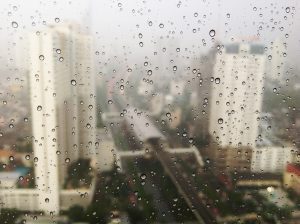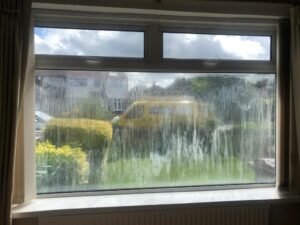Condensation in your home can be a worry as it’s a common cause of damp and mould, and it’s often noticeable on or in your windows. You’re probably wondering what’s causing condensation, how you can get rid of it and how to stop it coming back. We’ve covered all of this and more to help you understand what might be the cause and whether you may need to replace your double or triple glazed windows to resolve the problem.
What causes condensation on windows?
Condensation happens when warm or moist air comes into contact with cold glass or a cool surface. It isn’t uncommon, so many homeowners overlook it when it appears on their windows. Condensation can form on any colder surface, and we see it every day with droplets forming on mirrors, tiles and shower panels in your bathroom after a hot shower.
As winter approaches after a hot summer, our PVC windows and doors are more prone to becoming misshapen. This is because repeated exposure to quickly fluctuating temperatures can distort certain materials. Our windows and doors are exposed to more heat in the daytime and cooler autumn nights. This can expand and shrink the seals of double-glazed units, causing some damage to the quality of the seals which leads to condensation.
Why do my windows have condensation on the outside?
Condensation found on the outside of your windows is perfectly normal. It’s a sign that your double-glazed windows are highly thermally efficient as they are keeping the heat in and cold air out. This allows your home to maintain its temperature so you can stay comfortably warm and use less energy to heat your home. You’ll often find outer window condensation during the winter as the air is moist and the temperature drops.
Why do my windows have condensation on the inside?
Condensated windows inside the panes can be a cause for concern. It’s common to find condensation in your kitchen or bathroom, especially when cooking or taking a hot shower or bath. These activities release extra moisture into the air, increasing the overall humidity levels of these spaces. While some condensation is expected on cold surfaces, it’s still important to minimise potential moisture buildup in your home as repeated or constant condensation can lead to dampness and mould.
Indoor condensation isn’t limited to your kitchen or bathroom. Hanging up your washing indoors without using radiators, or hosting a large gathering of people, can cause steam to form on your windows too. You may even have excess condensation due to poor insulation in the roof or walls of your home.

What causes misted double glazing?
Condensation looks like a misted or cloudy window and can obscure your view outside whilst making your home look less appealing. If you notice you do have misted windows, this may mean your double glazing has ‘failed’.

1. Poorly fitted windows
If your windows were improperly installed, they’ll deteriorate quickly. In extreme cases, they could become cloudy in less than a year. When double glazing is fitted incorrectly, your window panes and frames won’t be aligned properly. This means your seals won’t last and gaps will form, allowing air and moisture into your panes.
2. Using the wrong products
You’d be surprised at how often double glazing can be damaged by human error alone. Many people use unnecessary harsh chemical products to clean their windows, which can reduce their effectiveness. A simple mixture of warm water and white vinegar is perfect to care for your windows and leave them sparkling for longer.
3. Damaged seals
Whether it’s poor installation or wear and tear, broken or faulty seals are one of the most common causes of cloudy and blown double glazing. Windows expand and contract when temperatures rise and fall. Although not visible to homeowners, this movement takes its toll on window seals, made worse by poor materials or shoddy craftsmanship.
Damaged seals allow moisture between the window panes, which is difficult to remove. Once inside, moisture causes condensation which means windows will become misted.
4. Window age
Time is another factor in the health of your double glazing. The date your double glazing was first installed impacts how well it will perform. Not only because the seals will become less effective over time, but also because modern fitting methods are more reliable.
How to prevent condensation in your windows
Condensation occurs in all homes and although it can lead to problems, there are initiatives you can take to help combat the effects. To stop or reduce condensation on double-glazed windows, there are a few things you can do to ventilate your home and reduce the risk of dampness and condensation.
Improve ventilation
By ensuring your home is properly ventilated, you’ll improve airflow and fight off issues caused by condensation. Opening windows and using vents or fans are all great ways to improve air circulation:
- Promote better airflow by opening windows or doors on opposite sides of your house
- Use exhaust fans in the bathroom and kitchen to extract humid air.
- Allow air to flow into your home slowly, without inviting in a draught, with trickle vents

Heating & insulation
Condensation issues are intensified by sudden rises and drops in temperature as fluctuations cause water to evaporate and condense when you turn the heating on and off. Make sure your heating and insulation efforts are working hard to help you avoid condensation by:
- Keep your heating at a constant low temperature
- Ensuring your home has cavity wall and loft insulation
- Checking your windows for draft, damp or steam
Clear moisture
An immediate solution to condensation is to remove any water droplets you come across in your home. In the short term, cleaning windows of condensation regularly can prevent moisture from developing into dampness or mould issues. Other things you can try to clear moisture in your home include:
- Use dehumidifiers
- Use condensation catchers
- Avoid drying clothes indoors
- Vent your tumble dryer properly
Common issues with condensation inside double-glazed windows
The place you should always be concerned about finding condensation is between the inner panes of double-glazed windows because it is a sealed unit. If condensation is appearing inside your double glazing, it’s often an indication that the seal around your windows has failed. Some other problems you might experience as a result of failed double glazing include:
- With air entering the gap between the panes, the windows will no longer be as effective for thermal insulation.
- Draughts can enter your home, cooling down your house. In colder months, you may see an increase in your energy bills as you try to combat the additional cold air.
- Moisture getting in between the panes of glass ruins the aesthetic of your windows and leads to bigger problems like mould, dampness, heat loss and poor energy efficiency.
How to get rid of condensation between window panes
If you’ve noticed condensation between your double glazing panes and you’ve tried everything to combat it, it’s probably time to get your double glazing replaced so you don’t experience any further problems.
We’ve dedicated years of expertise to fixing issues that can cause condensation on your windows. If you’d like help with your condensation problem, call our team now on 0800 182 2047. You can also contact us online to arrange a free consultation with our specialist engineers.
